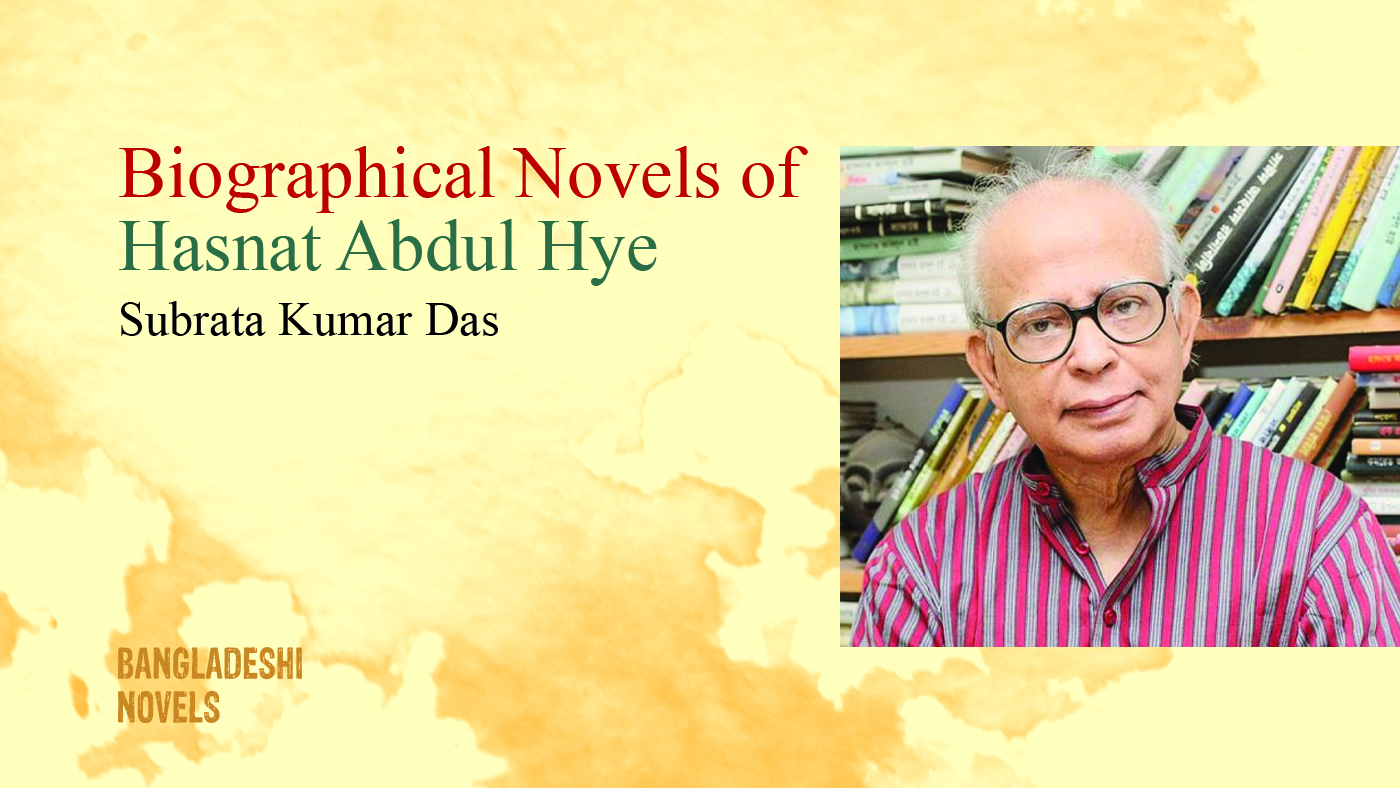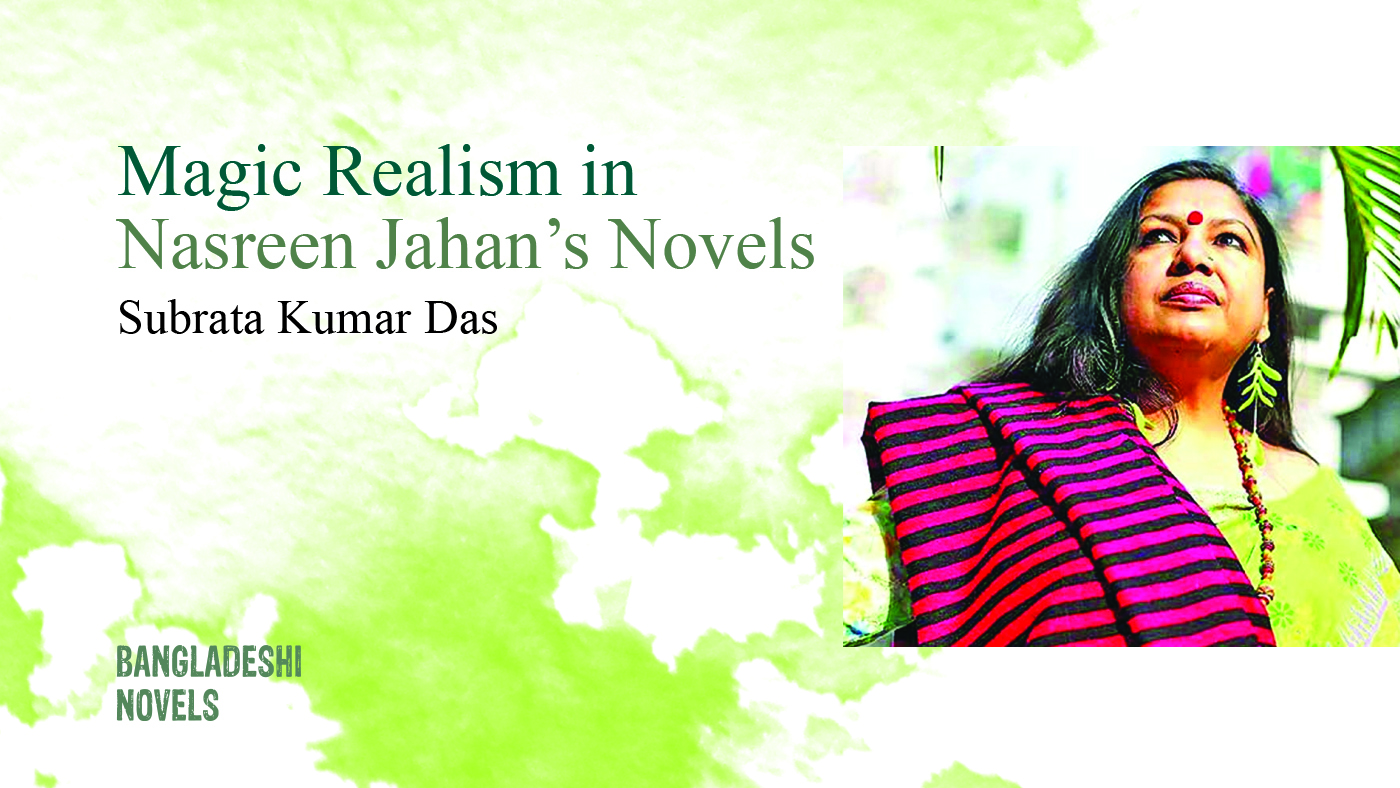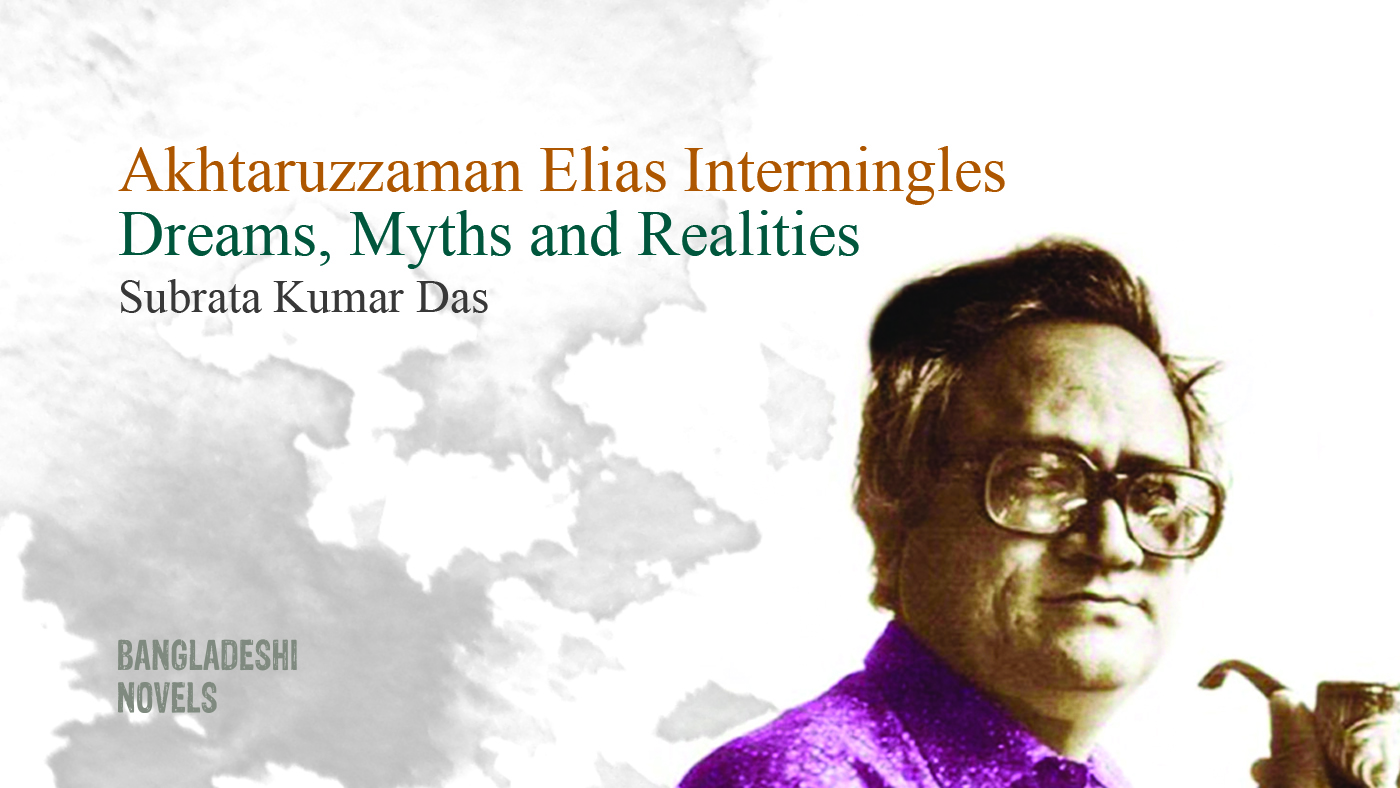
The eighth decade of the twentieth century proved very productive for Haripada Datta (b 1947). Later he passed the last decade across the Atlantic. Returning from there, he published his epoch-making novel Jonmo-Jonmantor (Birth and Rebirth, 2000), which may be actually considered the second phase of the novelist. In the first phase, he started his authorial career as a short story writer with Surjer Ghrane Phera and Joal Bangar Pala, both published in 1985. The first novel that he wrote was Eshane Ognidaho (Conflagration in the North-East, 1986) which took village people as its contents. The additional significance of that novel was the use of folk elements like proverbs, stories and rhymes in his novel which he exercised in a more skilled way in his second novel Ondhokupe Jonmothsob (Birth Ceremony in the Black Hole, 1987). The third and epic novel that he produced in that phase is Ojogor (A Boa), the two volumes of which were published in 1989 and 1991 respectively.
Eshane Ognidaho is a novel of class struggle. The novelist has presented the suppressed and oppressed section of our society through it. But more than that Haripada has shown the rise of that section in this novel, which he has done through the protagonist Abdulla. Abdulla is a peasant, but to maintain his livelihood he has accepted frog gathering as his occupation which is risky and goes beyond the practices of Islam. But he is compelled to do it as many others of his society. Jamir Ali and Fulbibi are two very significant characters who are his parents. On the other hand Sabiha, the daughter of a landlord, is his beloved lady.
But the irony lies in the fact that the landlord is the main obstacle to all the prosperities of the peasant section. He does not hesitate to make the land of other poor people flood to save his own’s. though he gives prior words, he does not supply water to their fields from his shallow machine during dry season. Moreover he arranges marriage of his daughter with Helal, an immoral cousin of Sabiha. As decided previously, Abdulla comes to the bamboo bushes in the evening of the marriage ceremony, but Sabiha doesn’t come in fear of future poverty. Thus Haripada Datta has set the context of his novel in the agrarian impoverished society of our country where being repeatedly deceived the common folk rise up crossing all obstacles around them.
The other fellow peasant Mojid voiced highly against the misdeed of the landlord and the representatives of the local government like Member and Chairman of the Union Parishad. As a result they plotted against him and he was sentenced to jail. Returning from the jail, Mojid becomes a flame of fire and encourages others to be united against the oppressors. Resultantly, he is again trapped and the people of Helal, the forthcoming landlord, uproot his eyes, on a false charge of dacoity in Kala Matubbar’s house. In the same time the claws of Helal sharpen and sharpen – he begins to grab the lands of small farmers. Abdulla and others desire to be united, but time and again they fail till the last incident occurs in which the people of Helal kill Kutub, a fellow worker of Abdulla, and his wife, after violation. Police come and directed by Helal arrest Abdulla to take him to the Thana. The novelist has not left the novel finish this way – one way the police take Abdulla, the other way we see people of Abdulla’s community swarm around the house of Helal, set fire to his crop house and a spear pierces the chest of Helal himself.
All the setting of the three novels of Haripada Datta is the locality of Ghorashal, Kaligonj and Palash of Gazipur district. Not only the characters of the novels use the dialect but the narration also takes the touch of that local language. Moreover the use of folk elements also becomes prominent from the very debut novel of Haripada which proves more successful in Ondhokupe Jonmothsob Herewith it is worthy to mention that probably no other fictionist of Bangla language has ever been so successful in using folk elements in fiction.
In the second novel, the writer has used the love-story of Hasan-Rubina as the main chain of all the episodes of the novel. On the very outset, we meet Hasan waiting for Rubina at the railway station. Rubina, a village girl and fiancée of Hasan, has taken a job in a garments factory situated at Dhaka very recently and she visits the village house on weekends. But gradually Hasan feels that the contents of Rubina’s talk only include cinema and other things of the town society, they do not posses the sincerity as they did beforehand. All her behaviours make Hasan understand that the town culture and money are changing the mind of Rubina. Rubina’s mother also doubts the changes of her behaviour but they all are helpless as Rubina is the only child of her parents and she is to earn for the whole family. The reasons behind the changes of Rubina spring up when an elderly colleague of the office tells her of a magic way to earn money which gradually drags her to the street. Does not she return to her home and Hasan? Yes she does, when she realises the falsity of all these activities.
Through the story of Hasan–Rubina, the novelist has expressed the deterioration of rural mind coming in contact of urban culture. But more than that he has uphold the sincerity of love of village people as well. But what poses as the final theme of the novel Ondhokupe Jonmothsob? – the revival of unity and courage among the oppressed, as we observe in Eshane Ognidaho. In Ondhokupe Jonmothsob, Farid Ali, a farmer’s son, leads the whole community to the destiny of unity, where Hasan plays a very vital role. They raise their voice for the demand of increased labour payment. The agents of the local administration do not sit idly. Condemning Hasan in a dacoity case of Shibpur, they give him inhuman punishment. This time the co-fighters of Hasan fail to save him, but in the rains they all unitedly succeed. When the Union Parishad Member hires labourers from a nearby village, Hasan and his fellow challenge them violently. When the Member brings police who arrest and take Hasan to the Thana, Hasan’s fellows kidnap the Member’s son and last of all the Member get compelled to free Hasan from the Thana. But the fight between the haves and have-nots do not end here. The feudal agents detect Farid Ali as the root of all revolutionary activities and to root him out they kill Farid Ali. But the plot-makers of his death cannot remain aloof from the eyes of Hasan. So when the Member Mamud Ali visits the spot, he receives strike of a spade on head from Hasan. The novel ends with the massage of making all the people of the community to be alert against the attack of the oppressors.
Though a reader may discover a semblance between the themes of the first two novels of Haripada Datta, the third and the epic novel Ojogor takes a different and large historical time as its theme. Starting from the second decade of the twentieth century the novelist extends his story upto the eighth decade i.e. near about the whole century takes place in this novel. And possibly no other Bangla novel has taken so long a time of the twentieth century. The other novels that have taken the story and history of Bangla are Sangsaptak (1965) by Shahidulla Kaiser, Padma Meghna Jamuna (1974) by Abujafar Shamsuddin and Gayatree Sondhya (1994-5) by Selina Hossain. Haripada Datta has manipulated his story in such a way that his story has intermixed with the history of Bangla of the century. The people, their thoughts and ideas as well as evolution of their mind have been the focal ideas of the author.
Ojogor opens with Adom Ali, a poor peasant of this soil and thus the novelist wants to highlight the have-nots of our society. Through his novel Haripada actually does not tell the history of the higher class, rather the sorrows and sufferings of the underprivileged class come forward. Presenting the people of the lower occupation, Ojogor gradually presents itself as a completely political novel. We can realise that every man of the society is a victim of politics in his personal and social behaviour. Gradually, political parties and the movements of them appear prominently before us. Muslim League, Congress, Khelaphot Movement, Swadeshi Movement, Swaraj, Communist Party, Krishak Sabha everything penetrate into the story line of the novel. In the second century, parties like Muslim League and Congress were out of reach of the commoners, they were the sole property of the upper class people. The commoners began to involve more and more when Swadeshi Movement began its journey as a result of which the name of Kshudiram became a popular word to the common folk. Later on we observed the emergence of Krishok Sabha and Communist Party – people who earlier worked for Swadeshi Movement got gradually involved in the Communist Party. In Ojogor such a character is Ananda Bagchi, a Mathematics Teacher of a High School, who previously got imprisonment for having connection with the Swadeshis now become an active worker of the Communist Party. The politics of Ananda Bagchi began to encourage the mass people of our country for the first time. This transitory period of Bangla has been demonstrated very successfully in Gungmoy Manna’s Lokhindor Digar (1950) and Sulekha Sanyal’s Nobankur (1956).
Earlier Congress was limited between Jamindarbabu, his Nayeb, Nibaran Chakravarty, Headmaster Harish Mukherjee, whereas Muslim League was for Syed Sher Ali, Abdul Kuddus and Mofizuddin Chowdhury; on the other hand Communist Party went deep of the society. ‘Kafer’ i.e. infidel was the black mark that Communist Party had to bear since its inception. Haripada Datta has delineated all these socio-political elements from the very root of their history. Meanwhile there appeared the question of election for which we got a new party called Krishak Praja Party led by Fazlul Huq. In the election Krishak Praja Party candidate wins but the reality is they become less interested to materialise the pre-election slogans for which the common folk got so enthusiastic regarding election. Later on those slogans become the slogans of the Krishak Samity led by Ananda Bagchi.
Ojogor is a novel of direct political picture of Bangla for which once upon a time the panic of bombing and collecting money for the second world war come. Ananda Bagchi and his party are dead against of any sort of support to this colonial war – resultantly he gets imprisonment again. In the meanwhile the question of Pakistan, an independent state for the Muslims come into limelight. In such a tumultuous time the Communist Party begin the Tebhaga Movement where participation of the Muslim activists is also noteworthy. But partition becomes inevitable which initiates Hindu – Muslim riot and we observe that the people who took part in Tebhaga Movement try utmost to resist riot. Regarding riot, migration of Hindus from Pakistan and Muslim from India, Tebhaga Movement and torture by police of Tebhaga activist Sabitri Roy’s Swaralipi (1952) and Pakadhaner Gaan (1956-8) and Akteruzzaman Elias’ Khoabnama (1996) are the most successful instances.
Political tumult was a common phenomenon during the pre-liberation days, as it was in post liberation period also. But nothing of them was for the common people of the country. For that reason immediately after the partition of 1947, the people of East Pakistan heard that Urdu would be the mandatory language, there shall have no place of Bangla. Moreover they heard that the Communist Party had been banned as it was a party of the Hindus. Gradually the common people began to realise everything for which the liberation war of 1971 was accelerated. To sketch the liberation war Haripada Datta has mentioned the necessary political events of the decades like: India – Pakistan war of 1965, division of Communist Party, emergence of Awami League under the leadership of Sheikh Mujib and his Six Point Movement etc. The first part of the novel ends with the injured teen boy Joinal, hurt by the hooligans of Chairman Sekandar Ali in the procession to participate the meeting of Bhashai.
At the beginning of the second part we meet Maulana Imam Hossain Sultanpuri who explains before a meeting that the demand of self-governance is similar to enmity of Islam. He also demonstrates it as a conspiracy of the Kafers. Alongside this opposition of self-governance, Haripada Datta has delineated the movement for it also. In a very meticulous way, the novelist has presented the different opinions, ideologies and parties in favour and against the political movements till the liberation war. Thus the novel proceeds through the pre-liberation period to a post-liberation era. After the war, we observe that the freedom fight has been guaranteed as a sole possession of the Awami League for which the youth generation demoralises and after some years through the famine of 1974, we reach 15 August 1975, when the radio announces: Sheikh Mujib has been killed.
This political milieu of the country takes place through the story of Khaleq and later on his son Joinal. Though Ojogor does not proceed with any particular individuals, the characters like Khaleq and Joinal play tremendously. In the pre and post partition day Khaleq is a courageous activist of Tebhaga Movement and Communist Party. During the mass movement of 1969 Khaleq’s son Joinal comes forth. Tormented by different ideologies he falls in a fix which one he is to support. Joinal feels that liberation movement should be the priority but how much liberation will fulfill the needs of the poor is a question to him. For this reason he tells his mother, ‘Do you know what shall I be? I’ll be a Sheikh Mujib and a Lenin’. Everyone knows that this dilemma was a common question to the whole nation those days.
The social development of the whole nation – of both Hindu and Muslim – is also a consideration of the novelist. All the professional groups, irrespective of high or low, take place in the novel. How the couture of ‘untouchable’ decreased is also a major phenomenon of Haripada’s novel. And in this context we see there occur various conflicts like between the oppressor and the oppressed, Hindu-Muslim, communist-non communist, supporter and betrayer of liberation war etc.
In the novel the symbol of an Ojogor i.e. boa is used in a very skilled way. From the very beginning pages the presence of it is felt. At first the slough is seen. Remembering the cry of fox at dead night from the Gajari jungle villagers assume the presence of a boa there. Whenever the question of injustice takes upper hand, the existence of the boa is felt more and more. But last of all we discover the huge snake in the briefcase of Joinal. After the liberation war as the partisans of Awami League grab everything, and the common people begin to be deprived for which Joinal protests. As a result of such rebellious activity when the Rakshibahini come to the village he is to go for a hide. After the assassination he again comes out and in the regime of Ziaur Rahman is compelled to meet Shahid Master, the Chairman. Thus he bow downs to the business of licensee and permits. From the chairman he receives the briefcase which takes following description:
Joinal walks with the briefcase in his hand. The empty briefcase suddenly seems very heavy to him as if his right hand would tear off for the weight of the briefcase. All on a sudden he topples down in dark and the briefcase opens out. Darker than the darkness of the night the huge boa comes out and bites up Joinal’s right hand.
In his first two novels Haripada Datta has tried to present the victory of the proletariat people. But in Ojogor he does not do so. It is possible that after his long experience the novelist has reached the truth that Bangladesh can never be a nation free of evils, inhumanity and immorality. As a result we do not get Joinal as one victor even after all his active struggles.







